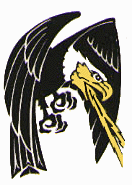
The Thunderbird. Image from Deities & Demigods (Lake Geneva: TSR Games, 1980), 16.
|

he legend of the Thunderbird is an ancient myth that survives even to the present day in some Native
American cultures. Though the Thunderbird myth varied from region to region and tribe to tribe,
the Thunderbird was, in the eyes of the ancient Native Americans, a magical animal that was sent
by their gods to protect them from the powers of evil. Riding on the wings of the storm, the Thunderbird
embodied the power of the storm. Its eyes flashed fire, its cry was like the crack of lightning,
and its mighty wings beat with the sound of rolling thunder, ever protecting its people from the powers
of evil.
There are at least three different legends of the Thunderbird available to us today, that can give us some
information about what this creature was like. The first comes from the Winnebago Indians of the northern
Midwest and Plains states, a second comes from the Passamaquoddy Indians of Maine, and a third comes from
the Quillayute, a Chimakoan tribe living along the Quillayute River, a six-mile river on the Olympic
Peninsula, near Seattle, Washington.

The Winnebago were an ancient and powerful people that once spread out from Wisconsin all across the northern
Midwest and Plains states to Nebraska. They believed that the Thunderbirds were powerful, eagle-like
divine creatures that were able to affect the winds and created storms, lightning, thunder, and rain.
They also believed that they could take the form of humans, and that some humans, though not actually
Thunderbirds, shared their characteristics and were considered to be semi-divine.
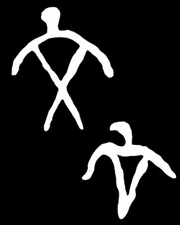
Thunderbird figures from the Sacred Rock, Brown's Valley, Minnesota.
|

Thunderbird figures from Washington County, Minnesota (top left), and from the Three
Maldena Area in the Pipestone National Monument, also in Minnesota.
|
This thought is reminiscent of the "bird-man" concept prevalent at
Cahokia
, and it is believed that the Cahokians were related to the Winnebago peoples.
Richard L. Dieterle explains in
The Short Encyclopedia of Hotc�k (Winnebago) Myth, Legend, and Folklore,
Thunderbirds are powerful and warlike avian spirits who animate the gray clouds with thunder and lightning.
Together with the Waterspirits, they were the first spirits that Earthmaker created. Their name, Wak'�dja,
means, "Divine Ones." On the model of other tribes, they are conventionally called "Thunderbirds," since
they alone possess lightning. Their basic somatic form runs the gamut of several species of birds,
the hawk and the eagle being the most common. However, they are far stronger in build and have polychrome
plumage that gives them a magnificent appearance unrivaled by the birds of earth. Their voices are like
the sounds of flutes, recalling both the whistle of wind and the voices of raptors.
1
The enemies of the Thunderbirds in Winnebago legend are the "Water Spirits". These became the enemies of
the Thunderbirds in primordial times, when the Thunderbirds shot their lightnings everywhere, including
the waters. The Thunderbirds still use their lightning when crossing the waters, as that helps protect
them from the waterspirits. The Winnebago believed that all lightning was directed at Waterspirits,
which lived in bodies of water, or in streams of water beneath the surface of the Earth. The waterspirits
were the favorite food of the Thunderbirds, though they usually ate animals and sometimes even humans.

Another primary source is from the legends of the Passamaquoddy Indians,
who lived in the northeast, in the Quoddy Loop area of Maine and New Brunswick. In this story, two Passamaquoddy
Indians went on a quest to find the origin of thunder:
This is a legend of long, long ago times. Two Indians desired to find the origin of thunder. They
travelled north and came to a high mountain. These mountains performed magically. They drew
apart, back and forth, then closed together very quickly.
One Indian said, "I will leap through the cleft before it closes. If I am caught, you continue to
find the origin of thunder." The first one succeeded in going through the cleft before it closed,
but the second one was caught and squashed.
On the other side, the first Indian saw a large plain with a group of wigwams, and a number of
Indians playing a ball game. After a little while, these players said to each other, "It is time to
go." They disappeared into their wigwams to put on wings, and came out with their bows and
arrows and flew away over the mountains to the south. This was how the Passamaquoddy Indian
discovered the homes of the thunderbirds.
The surviving Passamaquoddy Indian brave had discovered the home of the Thunderbirds, but the
intrepid Indians who had set out on a quest for the source of thunder had gotten more than they
had bargained for. One Indian had died already, and his companion was about to undergo a
transformation:
The remaining old men of that tribe asked the Passamaquoddy Indian, "What do you want? Who are you?"
He replied with the story of his mission. The old men deliberated how they could help him.
They decided to put the lone Indian into a large mortar, and they pounded him until all of his
bones were broken. They moulded him into a new body with wings like thunderbird, and gave him
a bow and some arrows and sent him away in flight. They warned him not to fly close to trees, as
he would fly so fast he could not stop in time to avoid them, and he would be killed.
The Thunderbirds, according to the Passamaquoddy, were men who could transform themselves into
flying creatures. These men were also able to transform the Passamaquoddy Indian brave into a
bird like themselves. However, this brave now had a new enemy: Wochowsen, "great bird from the
south", who had control of the south wind, and made it blow so hard that the Passamaquoddy brave
could not return to his homeland.
The lone Indian could not reach his home because the huge enemy bird, Wochowsen, at that time
made such a damaging wind. Thunderbird is an Indian and he or his lightning would never harm
another Indian. But Wochowsen, great bird from the south, tried hard to rival Thunderbird. So
Passamaquoddies feared Wochowsen, whose wings Glooscap once had broken, because he used too
much power.
A result was that for a long time air became stagnant, the sea was full of slime, and all of the
fish died. But Glooscap saw what was happening to his people and repaired the wings of
Wochowsen to the extent of controlling and alternating strong winds with calm.
Legend tells us this is how the new Passamaquoddy thunderbird, the lone Indian who passed
through the cleft, in time became the great and powerful Thunderbird, who always has kept a
watchful eye upon the good Indians.
2
A belief in the magic of the Thunderbird is held by the Passamaquoddy, because he can tame the winds
alternating between calm and storms. In this way the Thunderbird was not merely seen as a large, natural
flying creature, but as at least a semi-supernatural creature with ties to the divine world above.
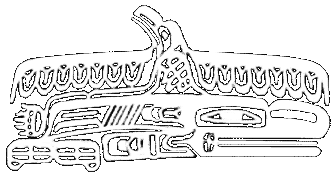
|
Thunderbird fighting with Killer Whale. From a Quillayute totem
|

Another Thunderbird story can be found in the myths and legends of the Quillayute Indians of the
Pacific Northwest. In this story, disaster had struck the Quillayute - rain and hail had fallen for
many days, destroying all of the edible plants and making it impossible to fish. Many of their people
had been killed by the hail, which was followed by sleet and snow. Out of food, the Quillayute were
desperate, and the Great Chief was forced to call upon the Great Spirit for help. The Great Spirit
answered, sending them the Thunderbird:
The people waited. No one spoke. There was nothing but silence and darkness. Suddenly, there came
a great noise, and flashes of lightning cut the darkness. A deep whirring sound, like giant wings
beating, came from the place of the setting sun. All of the people turned to gaze toward the sky
above the ocean as a huge, bird-shaped creature flew toward them.
This bird was larger than any they had ever seen. Its wings, from tip to tip, were twice as long as
a war canoe. It had a huge, curving beak, and its eyes glowed like fire. The people saw that its
great claws held a living, giant whale.
In silence, they watched while Thunderbird - for so the bird was named by everyone - carefully
lowered the whale to the ground before them. Thunderbird then flew high in the sky, and went back
to the thunder and lightning it had come from. Perhaps it flew back to its perch in the hunting
grounds of the Great Spirit.
Thunderbird and Whale saved the Quillayute from dying. The people knew that the Great Spirit had
heard their prayer. Even today they never forget that visit from Thunderbird, never forget that it
ended long days of hunger and death. For on the prairie near their village are big, round stones
that the grandfathers say are the hardened hailstones of that storm long ago.
The Quillayute described the Thunderbird as essentially a very large bird, though no bird in history
was ever as big as the type of bird they described, and of course no other bird ever had the same
supernatural powers:
Thunderbird is a very large bird, with feathers as long as a canoe paddle. When he flaps his wings,
he makes thunder and the great winds. When he opens and shuts his eyes, he makes lightning.
In stormy weather, he flies through the skies, flapping his wings and opening and closing his eyes.
Thunderbird's home is a cave in the Olympic Mountains, and he wants no one to come near it. If
hunters get close enough so he can smell them, he makes thunder noise, and he rolls ice out of his cave.
The ice rolls down the mountainside, and when it reaches a rocky place, it breaks into many pieces.
The pieces rattle as they roll farther down into the valley.
All the hunters are so afraid of Thunderbird and his noise and rolling ice that they never stay long
near his home. No one ever sleeps near his cave.
Thunderbird keeps his food in a dark hole at the edge of a big field of ice and snow. His food is
the whale. Thunderbird flies out of the ocean, catches a whale and hurries back to the mountains
to eat it. One time Whale fought Thunderbird so hard that during the battle, trees were torn up by
their roots. To this day there are no trees in Beaver Prairie because of the fight Whale and
Thunderbird had that day.
The battle between Thunderbird and Whale appears to be primarily symbolic of the battle between the air
and the sea, as imagined by the Quillayute in their attempt to interpret the forces of nature. Like most
ancient peoples, the Quillayute interpreted the forces of nature in symbolic forms, inventing gods and
goddesses, deities, and demigods as causes of these phenomena.
At the time of the Great Flood, Thunderbird fought a long, long battle with Killer Whale. He would
catch Killer Whale in his claws and start with him to the cave in the mountains. Killer Whale would
escape and return to the water. Thunderbird would catch him again, all the time flashing lightning
from his eyes and flapping his wings to create thunder. Mountains were shaken by the noise, and trees
were uprooted in their struggle.
Again and again Killer Whale escaped. Again and again Thunderbird seized him. Many times they fought,
in different places in the mountains. At last Killer Whale escaped to the middle of the ocean,
and Thunderbird gave up the fight.
That is why Killer Whales live in the deep oceans today. That is why there are many prairies in the
midst of the forests on the Olympic Peninsula.
3
It is interesting that the Quillayute mention the "Great Flood" in their description of the battle
between Thunderbird and whale. The story of a Great Flood that covered the Earth at one time is
nearly universal throughout the ancient world - but that is a story for another time.
The Quillayute legend describes the Thunderbird as a giant flying creature with feathers. According
to the geologic record, no avian (bird) was ever as large as the creature that the Quillayute
described. However, there were flying creatures that were that large - the giant pterosaur
Quetzalcoatlus Northropi,
native to the Mesozoic Period (65 million - 230 million years ago).
With a wingspan of 33 feet, Quetzalcoatlus Northropi was possibly the largest flying creature on
earth in any period. A fully grown Quetzalcoatlus was also quite capable of catching and carrying
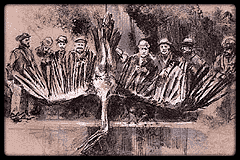
|
|
An artist's rendition of the controversial Thunderbird photo, allegedly taken in Tombstone, Arizona
in 1890. The creature shown here is essentially a pteranodon with feathers, though the oral account
makes no mention of feathers, and describes the creature as being much larger. Image from
Wierd Predators Petting Zoo: Thunderbird.
|
off a small whale like the Killer Whale. Absurd as this might seem, there have been sightings of similar
creatures all the way up to the present day in various parts of the world (see
The Mysterious Piasa Creature Part II).
One problem with this theory is the fact that the Thunderbird is described as having feathers. However,
recent evidence out of China suggests that at least some dinosaurs may have had feathers.
One controversial photo, which has now been lost (if it ever truly existed), shows a pterodactyl-like
creature with feathered wings being displayed by a group of men as a sort of hunting trophy. This
controversial photo, some believe was a sort of urban legend, a thing that never happened but was
believed by many to be true, despite the fact that large-scale searches have been made for the photo
without success.
The most celebrated Thunderbird encounter took place in 1890, on the desert sands of what was then the
Arizona Territory. Two cowboys had a bizarre confrontation which has varied widely in the telling, but
the gist of the story is this: they saw a giant flying bird, shot and killed it with their rifles,
and carried its spectacular carcass into town.A report in the April 26, 1890 Tombstone Epigraph
listed the creature's wingspan as an alarming 160 feet, and noted that the bird was about 92 feet long,
about 50 inches around at the middle, and had a head about eight feet long. The beast was said to have
no feathers, but a smooth skin and wingflaps "composed of a thick and nearly transparent membrane...
easily penetrated by a bullet." Perhaps the hardest part of this story to swallow is that two horses
could manage to haul a dead behemoth like this for any distance. The Tombstone newspaper printed
its highly embroidered version of the cowboy's sighting, which was spared from fading into obscurity
by its inclusion in a 1930 book on the Old West.
In 1963, the story came to the
attention of writer Jack Pearl, who revived the tale for an article in a pulpy men's adventure magazine
called Saga. As if the Epigraph report hadn't spiced up the facts enough already, Pearl liberally
embellished the encounter into a dramatic rip-snorter entitled "Monster Bird That Carries Off Human Beings!"
Pearl pushed the date of the encounter back to 1886, and he described the witnesses as two prospectors who
killed the bird and proudly showed off their trophy in Tombstone. Pearl also added some extra conflict by
telling of a how a second Thunderbird snatched up a heckler who had ridiculed the prospectors and flew away
with him in its talons. But Pearl's most significant editorialization was this: he said that the Epigraph
newspaper story had run with a photograph of the giant bird's carcass, nailed up to a wall with its mighty
wingspan unfurled, and a number of men posing next to it for scale.
4
So, despite the existence of plenty of secondary evidence, the quest for an actual photo or other decisive
evidence for the existence of a Thunderbird continues on. Like the quest for Piasa, dragons, and other
mythical monsters, the Thunderbird and its paranormal ilk continue to live on the fringes of human perception,
waiting for the lucky snapshot to snap them into focus.

Quetzalcoatlus Northropi
image at top � 2000
Shiraishi Mineo)

Unconvinced? Travel to the homelands of the Thunderbird and see for yourself!
Green Bay (Midwest)
The Winnebago do not remember a time when they did not live at Red Banks on the south shore of Green
Bay. Their occupation of Wisconsin is very ancient, perhaps thousands of years. Their homeland lay
between Green Bay and Lake Winnebago in northeast Wisconsin but they dominated the area from Upper
Michigan south to present-day Milwaukee extending west to the Mississippi.
Ho Chunk (Winnebago) Reservation
Wisconsin Ho Chunk Business Committee
Gordon Thunder, Chairperson
P.O. Box 667
Black River Falls, WI 54615
Tel# (715) 284-9343, Fax# 284-9805
Maine (Northeast)
The Quoddy Loop area of Maine and New Brunswick was once occupied exclusively by the Passamaquoddy,
and related tribes. These people lived by their skills on the abundant natural resources of woods,
mountains, and waters. During the winter, the tribe would move inland, relying on hunting in the
forests, while in summer, they would move to the coast and outlying islands to fish.
Passamaquoddy Tribe
Pleasant Point Reservation
PO Box 343
Perry, Maine 04667
(207) 853-2600
Quillayute River (Pacific Northwest):
Directions from the East (Port Angeles, Seattle, Tacoma)
From Port Angeles take highway 101, 50 miles to highway 110. Turn right and go 8 miles to
Three Rivers Resort. Turn right and go 1/4 mile turn left in to Leyendeckers boat launch.
Quileute Reservation
Quileute Tribal Council
Douglas Woodruff, Chairperson
P.O. Box 279
LaPush, WA 98350
Tel# (360) 374-6163
Fax# (360) 374-6311
Tombstone, Arizona
Tombstone lies about 70 miles southeast of Tucson, 20 miles east of the San Pedro river,
and 15 miles southwest of the Dragoon Mountains. Tombstone has a very
rich, Old West history,
worth the trip in and of itself.
Editorial
|
Fragments
|
Cave of the Mounds
|
Thunderbird
|
Sphinx IV
Register
for our Hall of Records Newsletter!
Questions? Comments? Suggestions? Advertising? Press Releases?
Contact us!

1
Richard L. Dieterle, ed.,
"Thunderbirds or Thunders (Wak'�dja, 'The Divine Ones')"
, in
The Short Encyclopedia of Hotc�k (Winnebago) Myth, Legend, and Folklore
(http://hotcakencyclopedia.com/ho.Thunderbirds.html).
2
Glenn Welker, ed.,
"The Origin of the Thunderbird" in Indigenous Peoples' Literature (http://www.indigenouspeople.org/natlit/natlit.htm).
3
Ella E. Clark,
"Quillayute" in
Indian Legends of the Pacific Northwest (Berkeley: University of California Press, 1953).
4
"Thunderbird"
Wierd Predators Petting Zoo (www.parascope.com).

 Freakylinks - Tales of the Crypto: Thunderbird
Freakylinks - Tales of the Crypto: Thunderbird
 Thunderbirds or Thunders (Wak'�dja, "The Divine Ones") [Winnebago Version]
Thunderbirds or Thunders (Wak'�dja, "The Divine Ones") [Winnebago Version]
 "The Origin of the Thunderbird" [Passamaquoddy version]
"The Origin of the Thunderbird" [Passamaquoddy version]
 The Thunderbird [Quillayute version]
The Thunderbird [Quillayute version]
 WINNEBAGO HISTORY�
WINNEBAGO HISTORY�
 Quillayute River Guide Service (Washington State)
Quillayute River Guide Service (Washington State)
 The Dinosauricon: Quetzalcoatlus Northropi
The Dinosauricon: Quetzalcoatlus Northropi
 Shiraishi Mineo - Dinosaur Art
Shiraishi Mineo - Dinosaur Art
 Wierd Predators: The Thunderbird
Wierd Predators: The Thunderbird
For more information about the subjects discussed in this article, please
refer to the following sources:


 Lost Cities of North and Central America
Lost Cities of North and Central America
David Hatcher Childress
Rating:
   
One of the popular "Lost Cities" series, this book is a must-have guidebook for mysterious
places in North and Central America.
This book received several good reviews
Click
here
to buy this book.
 Indian Legends of the Pacific Northwest
Indian Legends of the Pacific Northwest
Ella E. Clark
Though this book was first published in 1953, the stories and legends enclosed in Ms. Clark's book
are interesting in 1999. I was surprized to find a story and lore concerning a local rock painting
site. Each of the stories are indentified by the tribe or nation they come from. This book is a must
for anyone interested in Native American lore or legends.
Click
here
to buy this book.
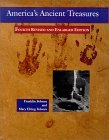 America's Ancient Treasures:
America's Ancient Treasures:
A Guide to Archeological Sites and Museums in the United States and Canada
Franklin Folsom, Rachel Folsom (Illustrator), Mary Elting Folsom (Contributor)
Rating:
    
America's Ancient Treasures (1993 Edition) is an excellent guide to every major and most minor
Native American archaeological sites and museums throughout the United States. First printed in
1971, it remains a standard reference tool for anyone interested in researching America's ancient
past.
Click
here
to buy this book.
 Atlas of the Mysterious in North America
Atlas of the Mysterious in North America
Rosemary Ellen Guiley, John A. Keel
Rating:
   
This atlas locates and gives brief descriptions of the most intriguing places in the United States and
Canada. Burial mounds, sacred places, ghost lights, haunted spots and even the locations of
cryptozoological sightings are covered. Find out if your state is home to a mystery, or peruse the atlas to
get ideas about where to go for your next vacation.
Click
here
to buy this book.

 Serpent Mound
Serpent Mound
Rusty Crutcher
Rating:
   
Crutcher's "Serpent Mound" is an excellent blend of piano and keyboards, Lakota flute, ocarina, and
exotic percussion, plus subtly blended environmental recordings. I highly recommend this CD as one
of the best of its genre I have heard. (The background music on this page is from "Shedding Skin",
the sixth track of this CD.)
Click
here
to buy this CD.
|
